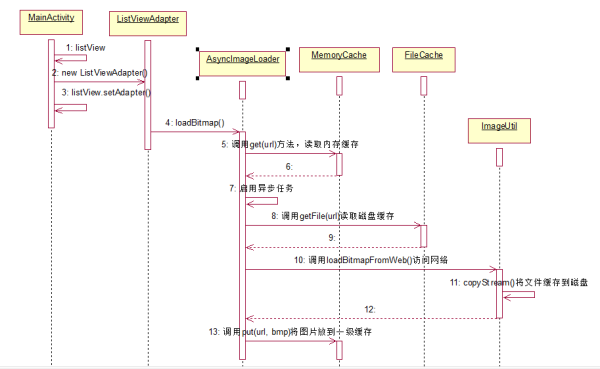您好,登錄后才能下訂單哦!
您好,登錄后才能下訂單哦!
Android中怎么異步加載網絡圖片,相信很多沒有經驗的人對此束手無策,為此本文總結了問題出現的原因和解決方法,通過這篇文章希望你能解決這個問題。
1、MemoryCache
在內存中存儲圖片(一級緩存), 采用了1個map來緩存圖片代碼如下:
public class MemoryCache { // ***的緩存數 private static final int MAX_CACHE_CAPACITY = 30; //用Map軟引用的Bitmap對象, 保證內存空間足夠情況下不會被垃圾回收 private HashMap<String, SoftReference<Bitmap>> mCacheMap = new LinkedHashMap<String, SoftReference<Bitmap>>() { private static final long serialVersionUID = 1L; //當緩存數量超過規定大小(返回true)會清除最早放入緩存的 protected boolean removeEldestEntry( Map.Entry<String,SoftReference<Bitmap>> eldest){ return size() > MAX_CACHE_CAPACITY;}; }; /** * 從緩存里取出圖片 * @param id * @return 如果緩存有,并且該圖片沒被釋放,則返回該圖片,否則返回null */ public Bitmap get(String id){ if(!mCacheMap.containsKey(id)) return null; SoftReference<Bitmap> ref = mCacheMap.get(id); return ref.get(); } /** * 將圖片加入緩存 * @param id * @param bitmap */ public void put(String id, Bitmap bitmap){ mCacheMap.put(id, new SoftReference<Bitmap>(bitmap)); } /** * 清除所有緩存 */ public void clear() { try { for(Map.Entry<String,SoftReference<Bitmap>>entry :mCacheMap.entrySet()) { SoftReference<Bitmap> sr = entry.getValue(); if(null != sr) { Bitmap bmp = sr.get(); if(null != bmp) bmp.recycle(); } } mCacheMap.clear(); } catch (Exception e) { e.printStackTrace();} } } 2、FileCache在磁盤中緩存圖片(二級緩存),代碼如下
public class FileCache { //緩存文件目錄 private File mCacheDir; /** * 創建緩存文件目錄,如果有SD卡,則使用SD,如果沒有則使用系統自帶緩存目錄 * @param context * @param cacheDir 圖片緩存的一級目錄 */ public FileCache(Context context, File cacheDir, String dir){ if(android.os.Environment.getExternalStorageState().equals、(android.os.Environment.MEDIA_MOUNTED)) mCacheDir = new File(cacheDir, dir); else mCacheDir = context.getCacheDir();// 如何獲取系統內置的緩存存儲路徑 if(!mCacheDir.exists()) mCacheDir.mkdirs(); } public File getFile(String url){ File f=null; try { //對url進行編輯,解決中文路徑問題 String filename = URLEncoder.encode(url,"utf-8"); f = new File(mCacheDir, filename); } catch (UnsupportedEncodingException e) { e.printStackTrace(); } return f; } public void clear(){//清除緩存文件 File[] files = mCacheDir.listFiles(); for(File f:files)f.delete(); } }3、編寫異步加載組件AsyncImageLoader
android中采用單線程模型即應用運行在UI主線程中,且Android又是實時操作系統要求及時響應否則出現ANR錯誤,因此對于耗時操作要求不能阻塞UI主線程,需要開啟一個線程處理(如本應用中的圖片加載)并將線程放入隊列中,當運行完成后再通知UI主線程進行更改,同時移除任務——這就是異步任務,在android中實現異步可通過本系列一中所用到的AsyncTask或者使用thread+handler機制,在這里是完全是通過代碼編寫實現的,這樣我們可以更清晰的看到異步通信的實現的本質,代碼如下
public class AsyncImageLoader{ private MemoryCache mMemoryCache;//內存緩存 private FileCache mFileCache;//文件緩存 private ExecutorService mExecutorService;//線程池 //記錄已經加載圖片的ImageView private Map<ImageView, String> mImageViews = Collections .synchronizedMap(new WeakHashMap<ImageView, String>()); //保存正在加載圖片的url private List<LoadPhotoTask> mTaskQueue = new ArrayList<LoadPhotoTask>(); /** * 默認采用一個大小為5的線程池 * @param context * @param memoryCache 所采用的高速緩存 * @param fileCache 所采用的文件緩存 */ public AsyncImageLoader(Context context, MemoryCache memoryCache, FileCache fileCache) { mMemoryCache = memoryCache; mFileCache = fileCache; mExecutorService = Executors.newFixedThreadPool(5);//建立一個容量為5的固定尺寸的線程池(***正在運行的線程數量) } /** * 根據url加載相應的圖片 * @param url * @return 先從一級緩存中取圖片有則直接返回,如果沒有則異步從文件(二級緩存)中取,如果沒有再從網絡端獲取 */ public Bitmap loadBitmap(ImageView imageView, String url) { //先將ImageView記錄到Map中,表示該ui已經執行過圖片加載了 mImageViews.put(imageView, url); Bitmap bitmap = mMemoryCache.get(url);//先從一級緩存中獲取圖片 if(bitmap == null) { enquequeLoadPhoto(url, imageView);//再從二級緩存和網絡中獲取 } return bitmap; } /** * 加入圖片下載隊列 * @param url */ private void enquequeLoadPhoto(String url, ImageView imageView) { //如果任務已經存在,則不重新添加 if(isTaskExisted(url)) return; LoadPhotoTask task = new LoadPhotoTask(url, imageView); synchronized (mTaskQueue) { mTaskQueue.add(task);//將任務添加到隊列中 } mExecutorService.execute(task);//向線程池中提交任務,如果沒有達到上限(5),則運行否則被阻塞 } /** * 判斷下載隊列中是否已經存在該任務 * @param url * @return */ private boolean isTaskExisted(String url) { if(url == null) return false; synchronized (mTaskQueue) { int size = mTaskQueue.size(); for(int i=0; i<size; i++) { LoadPhotoTask task = mTaskQueue.get(i); if(task != null && task.getUrl().equals(url)) return true; } } return false; } /** * 從緩存文件或者網絡端獲取圖片 * @param url */ private Bitmap getBitmapByUrl(String url) { File f = mFileCache.getFile(url);//獲得緩存圖片路徑 Bitmap b = ImageUtil.decodeFile(f);//獲得文件的Bitmap信息 if (b != null)//不為空表示獲得了緩存的文件 return b; return ImageUtil.loadBitmapFromWeb(url, f);//同網絡獲得圖片 } /** * 判斷該ImageView是否已經加載過圖片了(可用于判斷是否需要進行加載圖片) * @param imageView * @param url * @return */ private boolean imageViewReused(ImageView imageView, String url) { String tag = mImageViews.get(imageView); if (tag == null || !tag.equals(url)) return true; return false; } private void removeTask(LoadPhotoTask task) { synchronized (mTaskQueue) { mTaskQueue.remove(task); } } class LoadPhotoTask implements Runnable { private String url; private ImageView imageView; LoadPhotoTask(String url, ImageView imageView) { this.url = url; this.imageView = imageView; } @Override public void run() { if (imageViewReused(imageView, url)) {//判斷ImageView是否已經被復用 removeTask(this);//如果已經被復用則刪除任務 return; } Bitmap bmp = getBitmapByUrl(url);//從緩存文件或者網絡端獲取圖片 mMemoryCache.put(url, bmp);// 將圖片放入到一級緩存中 if (!imageViewReused(imageView, url)) {//若ImageView未加圖片則在ui線程中顯示圖片 BitmapDisplayer bd = new BitmapDisplayer(bmp, imageView, url); Activity a = (Activity) imageView.getContext(); a.runOnUiThread(bd);//在UI線程調用bd組件的run方法,實現為ImageView控件加載圖片 } removeTask(this);//從隊列中移除任務 } public String getUrl() { return url; } } /** * *由UI線程中執行該組件的run方法 */ class BitmapDisplayer implements Runnable { private Bitmap bitmap; private ImageView imageView; private String url; public BitmapDisplayer(Bitmap b, ImageView imageView, String url) { bitmap = b; this.imageView = imageView; this.url = url; } public void run() { if (imageViewReused(imageView, url)) return; if (bitmap != null) imageView.setImageBitmap(bitmap); } } /** * 釋放資源 */ public void destroy() { mMemoryCache.clear(); mMemoryCache = null; mImageViews.clear(); mImageViews = null; mTaskQueue.clear(); mTaskQueue = null; mExecutorService.shutdown(); mExecutorService = null; } }編寫完成之后,對于異步任務的執行只需調用AsyncImageLoader中的loadBitmap()方法即可非常方便,對于AsyncImageLoader組件的代碼***結合注釋好好理解一下,這樣對于Android中線程之間的異步通信就會有深刻的認識。
4、工具類ImageUtil
public class ImageUtil { /** * 從網絡獲取圖片,并緩存在指定的文件中 * @param url 圖片url * @param file 緩存文件 * @return */ public static Bitmap loadBitmapFromWeb(String url, File file) { HttpURLConnection conn = null; InputStream is = null; OutputStream os = null; try { Bitmap bitmap = null; URL imageUrl = new URL(url); conn = (HttpURLConnection) imageUrl.openConnection(); conn.setConnectTimeout(30000); conn.setReadTimeout(30000); conn.setInstanceFollowRedirects(true); is = conn.getInputStream(); os = new FileOutputStream(file); copyStream(is, os);//將圖片緩存到磁盤中 bitmap = decodeFile(file); return bitmap; } catch (Exception ex) { ex.printStackTrace(); return null; } finally { try { if(os != null) os.close(); if(is != null) is.close(); if(conn != null) conn.disconnect(); } catch (IOException e) { } } } public static Bitmap decodeFile(File f) { try { return BitmapFactory.decodeStream(new FileInputStream(f), null, null); } catch (Exception e) { } return null; } private static void copyStream(InputStream is, OutputStream os) { final int buffer_size = 1024; try { byte[] bytes = new byte[buffer_size]; for (;;) { int count = is.read(bytes, 0, buffer_size); if (count == -1) break; os.write(bytes, 0, count); } } catch (Exception ex) { ex.printStackTrace(); } } }四、測試應用
組件之間的時序圖:

1、編寫MainActivity
public class MainActivity extends Activity {
ListView list;
ListViewAdapter adapter;
@Override
public void onCreate(Bundle savedInstanceState) {
super.onCreate(savedInstanceState);
setContentView(R.layout.main);
list=(ListView)findViewById(R.id.list);
adapter=new ListViewAdapter(this, mStrings);
list.setAdapter(adapter);
}
public void onDestroy(){
list.setAdapter(null);
super.onDestroy();
adapter.destroy();
}
private String[] mStrings={
"http://news.21-sun.com/UserFiles/x_Image/x_20150606083511_0.jpg",
"http://news.21-sun.com/UserFiles/x_Image/x_20150606082847_0.jpg",
…..};
}
2、編寫適配器
public class ListViewAdapter extends BaseAdapter { private Activity mActivity; private String[] data; private static LayoutInflater inflater=null; private AsyncImageLoader imageLoader;//異步組件 public ListViewAdapter(Activity mActivity, String[] d) { this.mActivity=mActivity; data=d; inflater = (LayoutInflater)mActivity.getSystemService( Context.LAYOUT_INFLATER_SERVICE); MemoryCache mcache=new MemoryCache();//內存緩存 File sdCard = android.os.Environment.getExternalStorageDirectory();//獲得SD卡 File cacheDir = new File(sdCard, "jereh_cache" );//緩存根目錄 FileCache fcache=new FileCache(mActivity, cacheDir, "news_img");//文件緩存 imageLoader = new AsyncImageLoader(mActivity, mcache,fcache); } public int getCount() { return data.length; } public Object getItem(int position) { return position; } public long getItemId(int position) { return position; } public View getView(int position, View convertView, ViewGroup parent) { ViewHolder vh=null; if(convertView==null){ convertView = inflater.inflate(R.layout.item, null); vh=new ViewHolder(); vh.tvTitle=(TextView)convertView.findViewById(R.id.text); vh.ivImg=(ImageView)convertView.findViewById(R.id.image); convertView.setTag(vh); }else{ vh=(ViewHolder)convertView.getTag(); } vh.tvTitle.setText("標題信息測試———— "+position); vh.ivImg.setTag(data[position]); //異步加載圖片,先從一級緩存、再二級緩存、***網絡獲取圖片 Bitmap bmp = imageLoader.loadBitmap(vh.ivImg, data[position]); if(bmp == null) { vh.ivImg.setImageResource(R.drawable.default_big); } else { vh.ivImg.setImageBitmap(bmp); } return convertView; } private class ViewHolder{ TextView tvTitle; ImageView ivImg; } public void destroy() { imageLoader.destroy(); } }看完上述內容,你們掌握Android中怎么異步加載網絡圖片的方法了嗎?如果還想學到更多技能或想了解更多相關內容,歡迎關注億速云行業資訊頻道,感謝各位的閱讀!
免責聲明:本站發布的內容(圖片、視頻和文字)以原創、轉載和分享為主,文章觀點不代表本網站立場,如果涉及侵權請聯系站長郵箱:is@yisu.com進行舉報,并提供相關證據,一經查實,將立刻刪除涉嫌侵權內容。